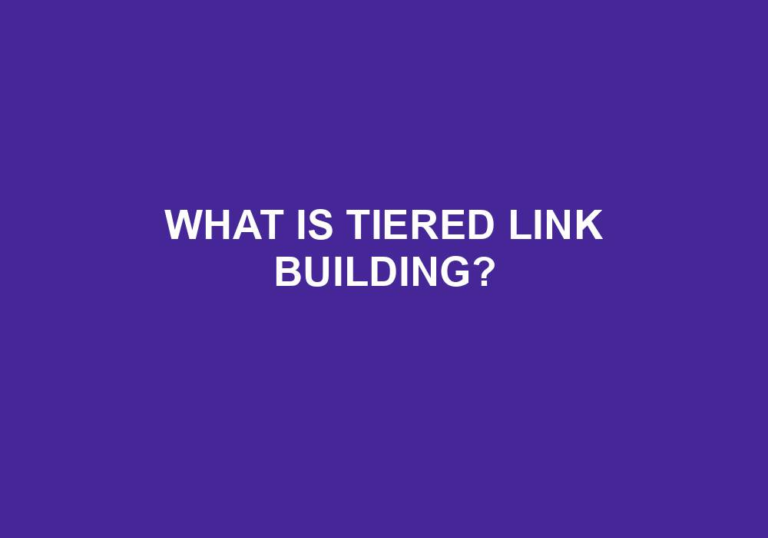In the vast landscape of search engine optimization (SEO), one crucial aspect that often gets overlooked is the quality of backlinks pointing to your website. While backlinks are essential for boosting your website’s visibility and authority, not all backlinks are created equal. A few toxic or bad backlinks can significantly hamper your site’s performance and even lead to penalties from search engines. So, if you’re ready to reclaim your website’s SEO health, join me on this journey as we dive into the world of bad backlinks and explore effective strategies on how to remove them.
Picture this: your website is diligently striving to climb up the search engine rankings, yet it seems to be stuck in a frustrating rut. The culprit might just be lurking in the shadows of your backlink profile. Bad backlinks, often originating from spammy or low-quality websites, can drag down your website’s reputation and hinder its potential for organic growth. But fear not! In this comprehensive guide, we will unravel the mysteries of bad backlinks and equip you with the knowledge and tools you need to identify, remove, and disavow these detrimental links. So, get ready to supercharge your SEO efforts by bidding farewell to those pesky bad backlinks, and let’s pave the way for your website’s success!
- Identify the bad backlinks by using tools like Google Search Console or third-party backlink analysis tools.
- Reach out to the website owners and request them to remove the links. Provide specific details and reasons.
- If the website owners don’t respond or refuse, disavow the bad backlinks using the Disavow Tool in Google Search Console.
- Regularly monitor your backlink profile to ensure no new bad backlinks are appearing.
How to Remove Bad Backlinks: A Step-by-Step Guide
In today’s competitive online landscape, having a strong backlink profile is crucial for the success of your website. However, not all backlinks are created equal. Some backlinks can actually harm your website’s search engine rankings and reputation. In this guide, we will walk you through the process of identifying and removing bad backlinks to ensure the health and credibility of your website.
Step 1: Conduct a Backlink Audit
The first step in removing bad backlinks is to conduct a thorough backlink audit. This involves analyzing your website’s backlink profile to identify any low-quality or spammy links. There are several tools available that can help you with this process, such as Google Search Console, Ahrefs, and Moz. Once you have gathered the necessary data, you can move on to the next step.
Step 2: Identify Bad Backlinks
Once you have conducted a backlink audit, it’s time to identify the bad backlinks. Look for links from irrelevant or low-quality websites, as well as links that come from link farms or directories. Pay attention to anchor text optimization, as excessive use of exact match anchor text can also be a red flag. Make a list of all the bad backlinks you have identified, as you will need this information for the next step.
Step 3: Reach out to Webmasters
Now that you have identified the bad backlinks, it’s time to reach out to the webmasters of the linking websites and request the removal of these links. Start by finding the contact information of the webmasters, which can usually be found on their websites. Craft a polite and professional email explaining the situation and kindly requesting the removal of the backlinks. Be sure to include the specific URLs of the bad backlinks and any other relevant information that may help the webmasters in identifying and removing the links.
Step 4: Disavow Bad Backlinks
If your attempts to have the bad backlinks removed are unsuccessful, or if you are unable to contact the webmasters, you can use the Google Disavow Tool to disavow these links. This tool allows you to tell Google to ignore certain backlinks when assessing your website’s search engine rankings. However, it’s important to use this tool with caution, as incorrectly disavowing links can have a negative impact on your website’s visibility. Create a disavow file containing the URLs of the bad backlinks and submit it through the Google Disavow Tool.
Step 5: Monitor and Repeat
After you have taken the necessary steps to remove or disavow bad backlinks, it’s important to monitor your website’s backlink profile regularly. Keep an eye out for any new low-quality or spammy links and repeat the process as needed. Remember that building a strong backlink profile takes time and effort, so it’s important to be proactive in maintaining the quality of your links.
Step 6: Improve Your Backlink Strategy
Removing bad backlinks is just one part of the equation. To ensure the long-term success of your website, it’s important to focus on building high-quality, relevant, and natural backlinks. Invest in creating valuable content that other websites would be eager to link to. Guest blogging, influencer outreach, and social media promotion are also effective strategies for acquiring high-quality backlinks. By continually improving your backlink strategy, you can strengthen your website’s authority and visibility in the online world.
Step 7: Track Your Progress
Finally, it’s crucial to track your progress and measure the impact of your efforts. Monitor your website’s search engine rankings, organic traffic, and backlink profile regularly to see how removing bad backlinks has positively affected your website’s performance. Use analytics tools such as Google Analytics or SEMrush to gain insights and make data-driven decisions moving forward.
Frequently Asked Questions
Here are some common questions about removing bad backlinks:
What are bad backlinks?
Bad backlinks are links that come from low-quality or spammy websites. These links can harm your website’s search engine rankings and reputation. They are usually created through unethical SEO practices such as link buying, link farms, or spammy link directories.
It is important to identify and remove bad backlinks to maintain a clean and healthy backlink profile for your website.
How do bad backlinks affect my website?
Bad backlinks can have several negative effects on your website. Firstly, search engines like Google consider backlinks as a ranking factor, and if you have too many bad backlinks, your website’s search engine rankings can drop significantly.
Secondly, bad backlinks can also result in a penalty from search engines. If search engines detect that you are engaging in manipulative or spammy link building practices, they can penalize your website by pushing it down in search results or even removing it from the index altogether.
How can I identify bad backlinks?
To identify bad backlinks, you can use tools such as Google Search Console, SEMrush, or Ahrefs. These tools provide backlink analysis features that allow you to see all the websites linking to your site and assess their quality.
Look for websites that have a low domain authority, contain irrelevant or suspicious content, or have a high number of outbound links. Also, check if the website is indexed by search engines and if it has been penalized before. These are all indicators of potentially bad backlinks.
How do I remove bad backlinks?
To remove bad backlinks, you have a few options. Firstly, you can contact the webmasters of the linking websites and request them to remove the links. Be polite and clearly explain why you want the links removed. Keep a record of your communication for future reference.
If you don’t receive a response or if the webmasters refuse to remove the links, you can disavow the backlinks using Google’s Disavow Tool. This tool tells Google to ignore those particular backlinks when evaluating your website’s ranking. However, use this tool with caution and only as a last resort.
How long does it take to see the effects of removing bad backlinks?
The time it takes to see the effects of removing bad backlinks can vary. After you have successfully removed or disavowed the bad backlinks, search engines need to crawl and re-evaluate your website. This process can take anywhere from a few days to a few weeks.
Once search engines have re-evaluated your website, you should start noticing improvements in your search engine rankings. However, keep in mind that removing bad backlinks is just one aspect of SEO, and other factors can also influence your website’s performance in search results.
In conclusion, removing bad backlinks is an essential practice for any website owner or digital marketer. By eliminating these harmful connections, you can improve your website’s overall performance and enhance its search engine rankings. Remember, the process of removing bad backlinks requires patience, diligence, and a comprehensive understanding of your website’s backlink profile. Start by conducting a thorough analysis of your backlinks, identifying toxic or spammy links, and reaching out to website owners to request removal. If necessary, disavow these links through Google’s Disavow Tool to signal to search engines that you do not endorse or associate with them. By consistently monitoring and maintaining a healthy backlink profile, you can ensure the long-term success and credibility of your website.
Furthermore, it is crucial to stay up-to-date with the latest SEO practices and algorithms to effectively remove bad backlinks. As search engines evolve, their algorithms become more sophisticated in detecting low-quality links. Therefore, it is essential to adapt your strategies and techniques accordingly. Regularly audit your backlink profile, utilize tools to detect and disavow toxic links, and maintain a proactive approach in building high-quality, relevant backlinks. Remember, the quality of your backlink profile is a reflection of your website’s authority and credibility in the digital landscape. By consistently monitoring and removing bad backlinks, you can optimize your website’s performance, rank higher in search engine results, and ultimately attract more organic traffic.





